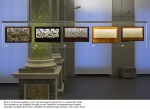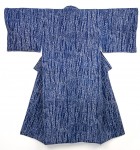 The Kunstgewerbemuseum (Museum of Decorative Arts) in Dresden has rediscovered an unparalleled archive of Japanese kimono stencils in its storage depot. More than 15,000 katagami stencils, elaborately carved paper stencils used to print patterns on kimono fabric, had slumbered uninterrupted by curatorial interest in 92 neatly stacked and numbered cases for 125 years. This is the largest collection of katagami in the world. The museum is making up for lost time now and has put 140 of the stencils on display along with historic kimonos in the Elbe Wing of the Japanisches Palais.
The Kunstgewerbemuseum (Museum of Decorative Arts) in Dresden has rediscovered an unparalleled archive of Japanese kimono stencils in its storage depot. More than 15,000 katagami stencils, elaborately carved paper stencils used to print patterns on kimono fabric, had slumbered uninterrupted by curatorial interest in 92 neatly stacked and numbered cases for 125 years. This is the largest collection of katagami in the world. The museum is making up for lost time now and has put 140 of the stencils on display along with historic kimonos in the Elbe Wing of the Japanisches Palais.
From the wealth of motifs in the Kunstgewerbemuseum’s collection, those depicting aspects of rain, which has a particularly significant cultural and spiritual role in a country exposed to monsoon winds and dependent on rice cultivation, have been specially chosen. The uniformity of tiny falling raindrops also seems to be reflected in the aesthetic logic of the repetitive structural designs of the printed pattern repeats. The Designs became more and more refined as the fabrics for which they were created were increasingly being produced for use by the samurai nobility for prestige and ceremonial purposes.
When the first katagami prints arrived in Europe in the 19th century, the highly sophisticated art of Japanese pattern design had a powerful influence on ornament in western fine arts, craftworks, and on the emerging discipline of industrial design.
 The Cooper-Hewitt Design Museum in New York City has one of the biggest collections of katagami in the United States with almost 400 examples. You can browse a selection of them in the museum’s collection database. You can see how the esthetic inspired western textile prints beyond the deliberate references of say, Art Nouveau’s Japonisme trend (compare this flying bat katagami in the Cooper-Hewitt collection to the Verneuil bats and poppies wallpaper in this post, for example). This water pattern could easily be a mod print from the 60s.
The Cooper-Hewitt Design Museum in New York City has one of the biggest collections of katagami in the United States with almost 400 examples. You can browse a selection of them in the museum’s collection database. You can see how the esthetic inspired western textile prints beyond the deliberate references of say, Art Nouveau’s Japonisme trend (compare this flying bat katagami in the Cooper-Hewitt collection to the Verneuil bats and poppies wallpaper in this post, for example). This water pattern could easily be a mod print from the 60s.
 It’s an ancient art, at least 1,000 years old. Katagami are made by layering three sheets of washi, paper handmade from the inner bark of the paper mulberry tree, and pasting them together with a persimmon juice lacquer. The final product is a flexible but strong paper browned by the tannins in the juice. Then the design is cut out of the paper using tools specific to the art. There are four cutting skills — Hiki-bori (long stripes cut towards the artist), Dogu-bori, (figurative carving using a number of cutting tools), Kiri-bori (circular holes) and Tsuki-bori (shaped punches) — that each artisan must master. The process is painstaking and requires intense focus of mind and hand.
It’s an ancient art, at least 1,000 years old. Katagami are made by layering three sheets of washi, paper handmade from the inner bark of the paper mulberry tree, and pasting them together with a persimmon juice lacquer. The final product is a flexible but strong paper browned by the tannins in the juice. Then the design is cut out of the paper using tools specific to the art. There are four cutting skills — Hiki-bori (long stripes cut towards the artist), Dogu-bori, (figurative carving using a number of cutting tools), Kiri-bori (circular holes) and Tsuki-bori (shaped punches) — that each artisan must master. The process is painstaking and requires intense focus of mind and hand.
 Once cut, the stencil is backed with a delicate interlacing net, the oldest of which were made from human hair strands but they were eventually replaced by stronger and more stable silk fibers. It can then be used in the katazome technique of resist-dyeing which entails spreading rice paste over the stencil onto the fabric. That’s repeated over and over again, each placement of the stencil carefully aligned to get an even print pattern throughout the textile. When the fabric is dyed, the areas with rice paste will not change color. Traditionally one katagami is used for one kimono, although that doesn’t mean each pattern is one of a kind since it’s possible for artisans to cut several katagami at the same time by stacking the prepared sheets.
Once cut, the stencil is backed with a delicate interlacing net, the oldest of which were made from human hair strands but they were eventually replaced by stronger and more stable silk fibers. It can then be used in the katazome technique of resist-dyeing which entails spreading rice paste over the stencil onto the fabric. That’s repeated over and over again, each placement of the stencil carefully aligned to get an even print pattern throughout the textile. When the fabric is dyed, the areas with rice paste will not change color. Traditionally one katagami is used for one kimono, although that doesn’t mean each pattern is one of a kind since it’s possible for artisans to cut several katagami at the same time by stacking the prepared sheets.
 Also known as Ise-Katagami because for centuries the Ise Province (modern-day Mie Prefecture) was the center of production. Artisans would create stencils that were used all over the country. The art, expensive, time-consuming and deeply connected to traditional Japanese clothing, declined after World War II. There are few masters still working today, most of them in the town of Suzuka where you can find the Ise Katagami Stencil Museum in an Edo Period historical landmark home. Perhaps the success of this great Gucci bag with the company’s trademark double-G logo applied using katagami and lacquer on deer leather is a harbinger of new life for the art form.
Also known as Ise-Katagami because for centuries the Ise Province (modern-day Mie Prefecture) was the center of production. Artisans would create stencils that were used all over the country. The art, expensive, time-consuming and deeply connected to traditional Japanese clothing, declined after World War II. There are few masters still working today, most of them in the town of Suzuka where you can find the Ise Katagami Stencil Museum in an Edo Period historical landmark home. Perhaps the success of this great Gucci bag with the company’s trademark double-G logo applied using katagami and lacquer on deer leather is a harbinger of new life for the art form.
Wondering how this marvellous collection could have ended up in Dresden, I stumbled upon physician, botanist, and traveler Philipp Franz von Siebold, who died in 1866. His daughter Kusumoto Ine was supposedly the first female doctor of Western medicine in Japan, who also founded a gynecology clinic, and there is even a granddaughter, here wearing a beautiful katakamized kimono in 1868. 😉